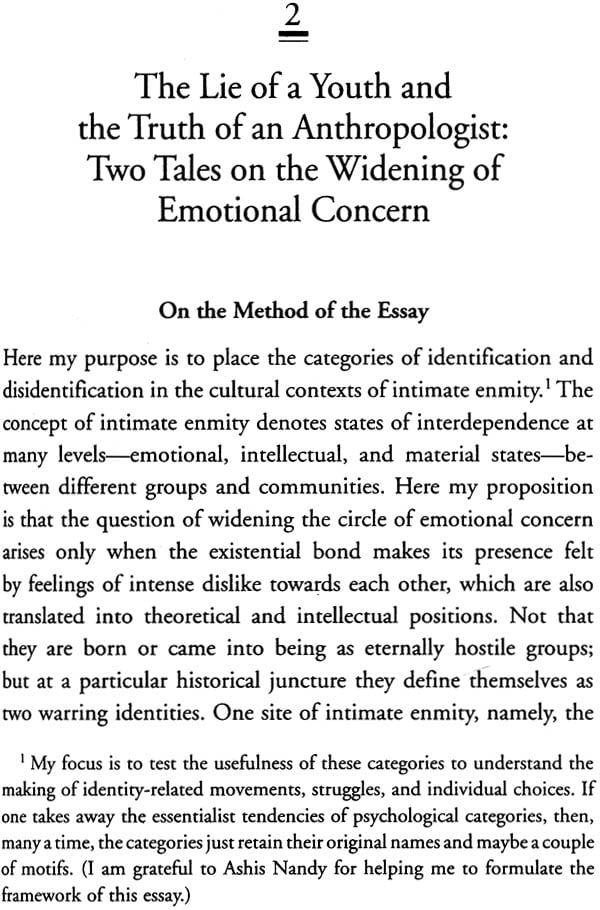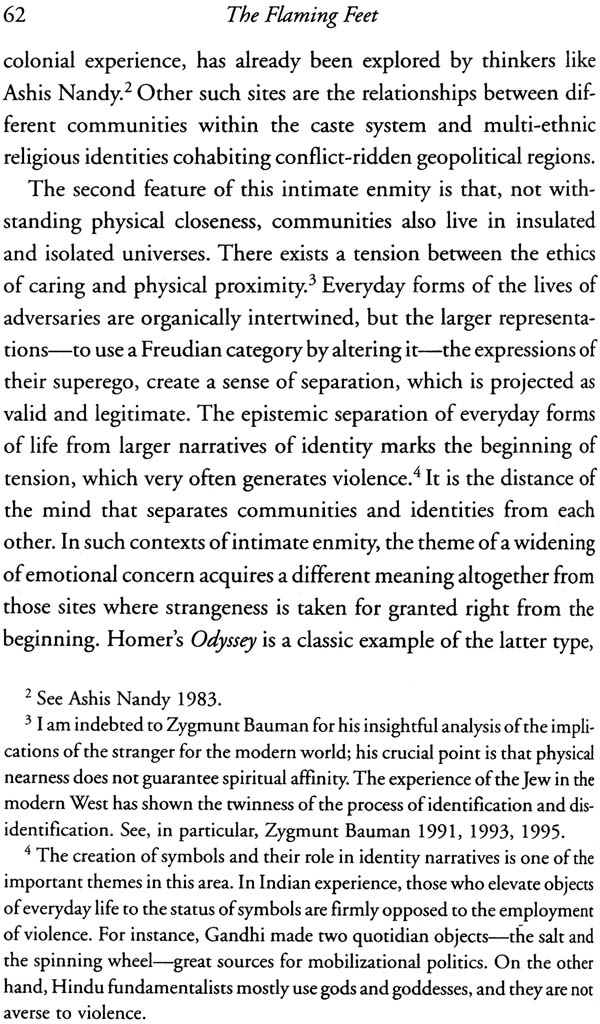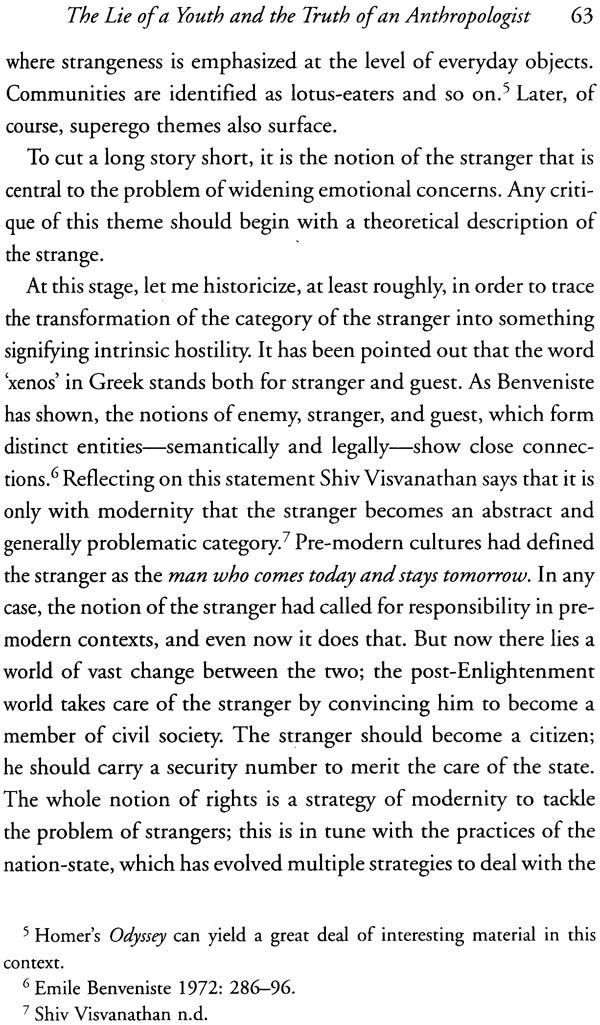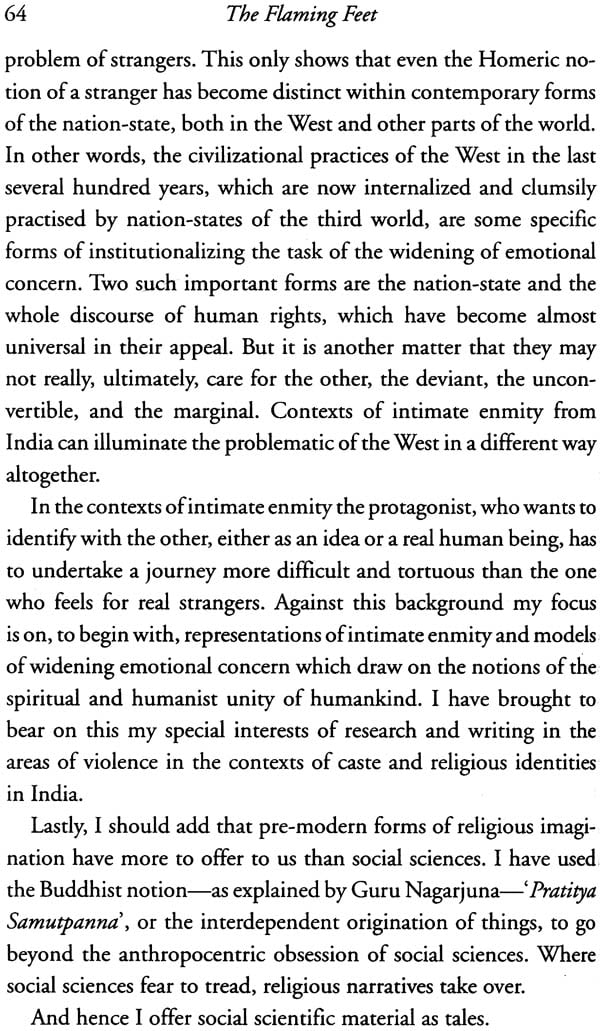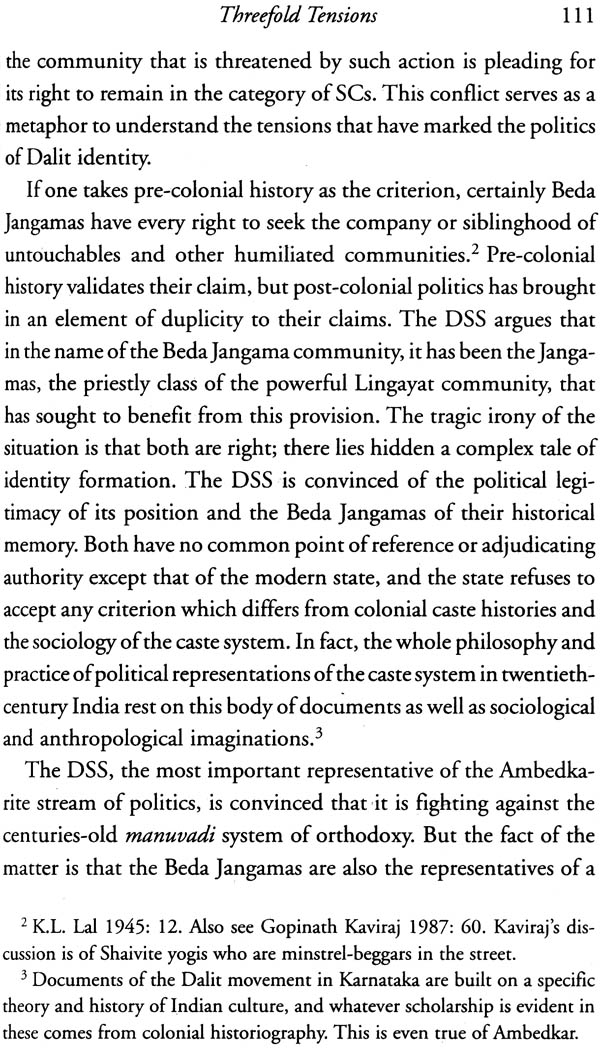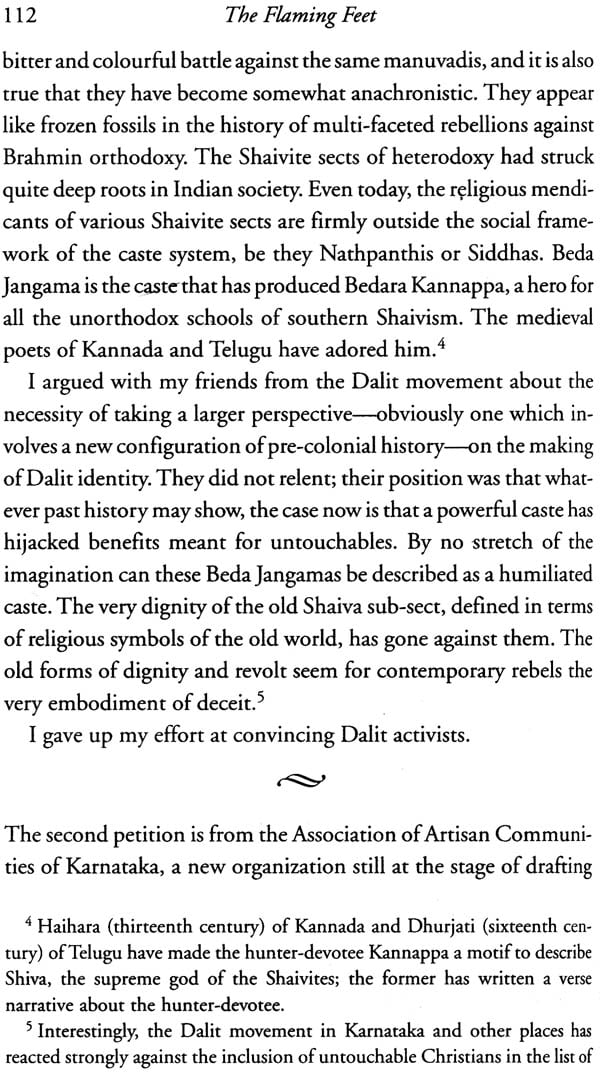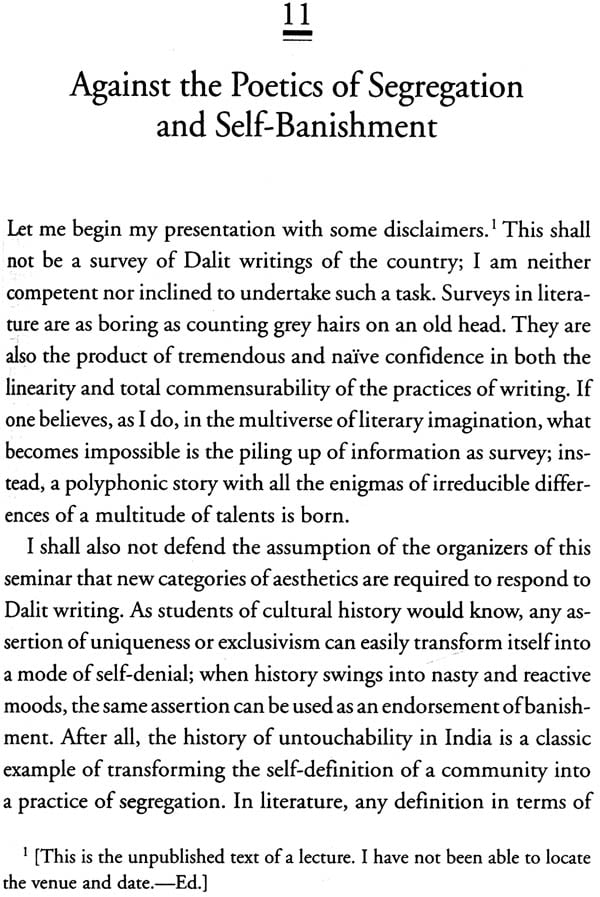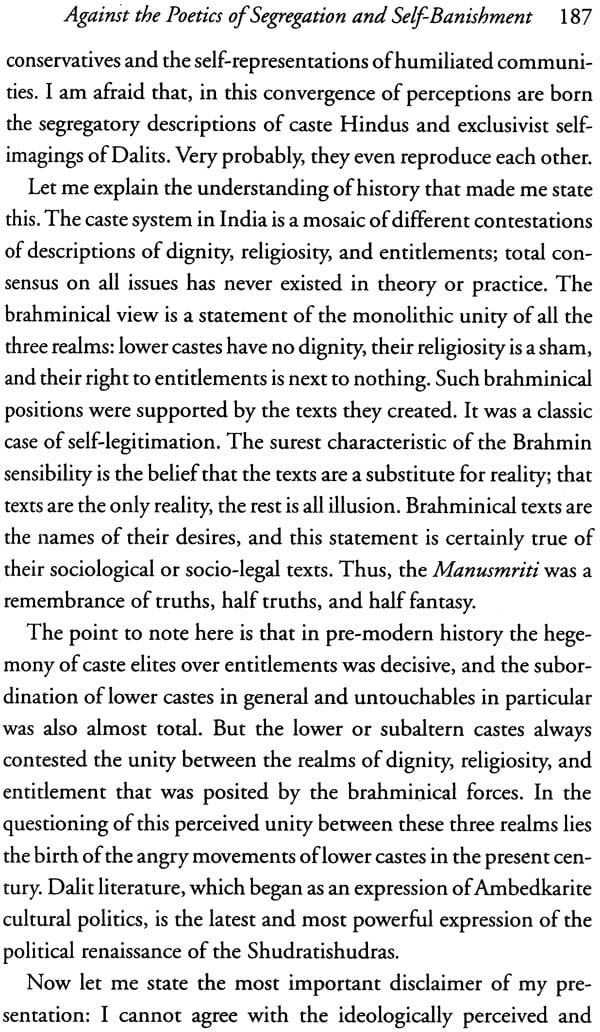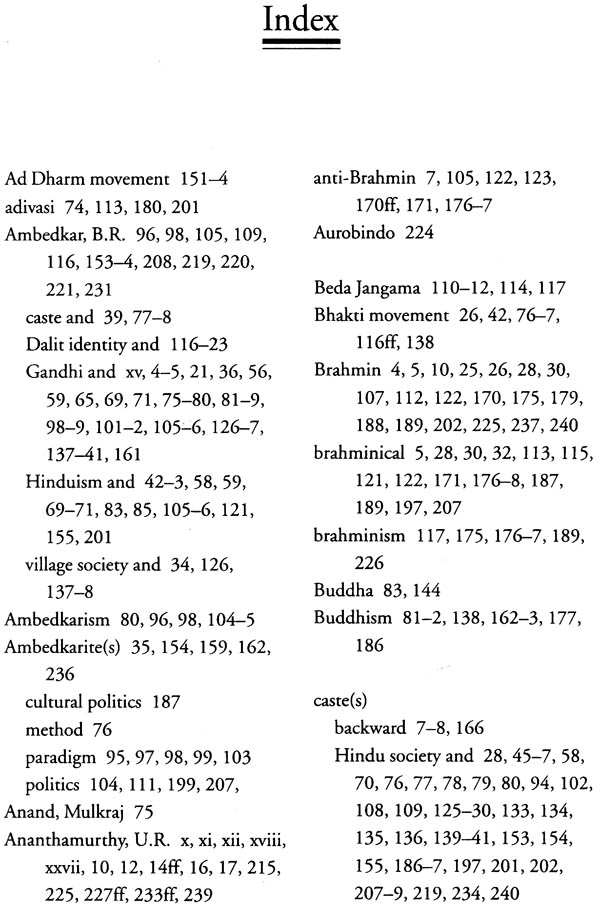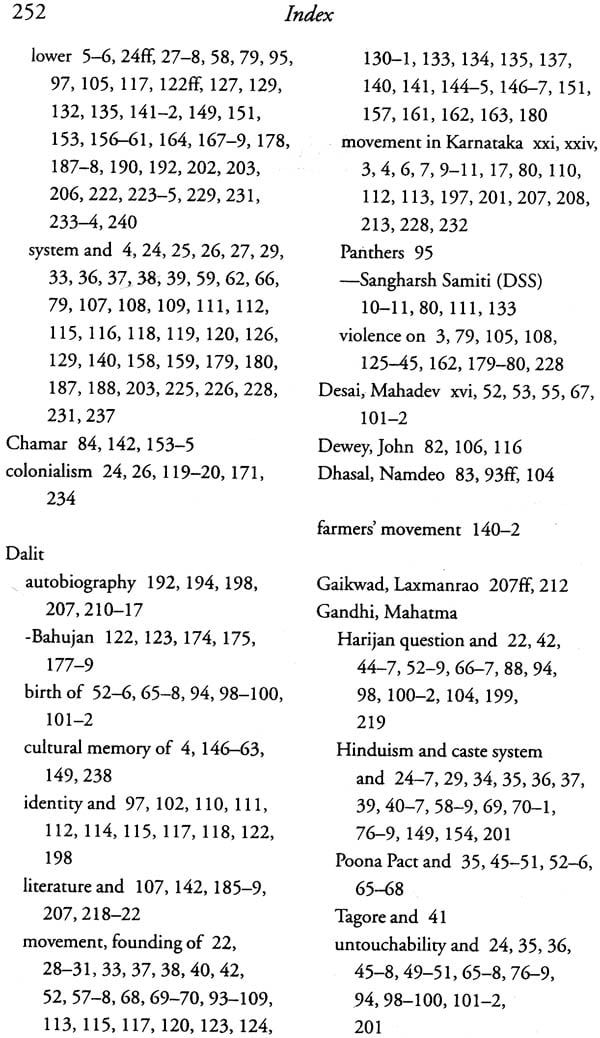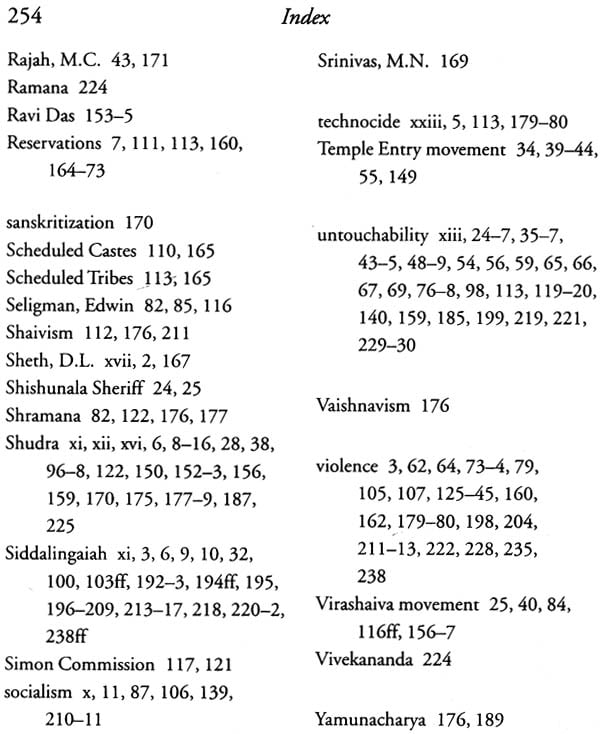
The Flaming Feet and Other Essays (The Dalit Movement in India)
Book Specification
| Item Code: | NAF917 |
| Author: | D.R. Nagaraj |
| Publisher: | Permanent Black |
| Language: | English |
| Edition: | 2012 |
| ISBN: | 9788178243580 |
| Pages: | 282 |
| Cover: | Paperback |
| Other Details | 8.5 inch X 5.5 inch |
| Weight | 280 gm |
Book Description
This book gives us D.R. Nagaraj’s vision of caste in relation to Dalit politics. It theorizes the caste system as a mosaic of contestations centred around dignity, religiosity, and entitlement. Examining moments of untouchable defiance, Nagaraj argues for a politics of cultural affirmation, for re-creating the banished worlds of gods and goddesses, and against self-pity and rage in Dalit artistic imagination.
D.R. Nagaraj argued for an alliance of the oppressed communities of India. This, he felt, entailed reconciling Gandhi and Ambedkar; recognizing that modernity has caused artisanal technocide; and reinterpreting untouchable pasts to show the autonomous cultural domain of humiliated communities. This is a foundational text for Dalit Studies.
Described by Ashis Nandy as the foremost intellectual to emerge from India’s vast non-English speaking world, D.R. Nagaraj (1954-1998) was a profound political commentator and cultural critic. Nagaraj’s importance lies in consolidating and advancing some of the ideas of India’s leading Dalit thinker and icon, B.R. Ambedkar.
With the death of Doddaballapur Ramaiah Nagaraj in 1998 at the age of 44, India lost a literary theorist and social critic who had barged into its familiar world of knowledge and scholarship to pose a challenge which political and social theorists in the country had struggled hard to evade. That challenge promised to supply if not the frame, at least the outlines of a culturally rooted and democratically sustainable radicalism for our times. This was a voice that did not condescend by seeking to speak on behalf of the ‘poor and oppressed’ from behind academic desks in metropolitan universities it was the autonomous voice and mode of self-expression of the excluded. It spoke from within their world and ventured a theory of us and our world. The dispossessed and the disempowered, in Nagaraj’s world, give you no scope for pity and have little patience 8ñth your sympathy. There is in them a robust, almost fierce, self-confidence that emerges neither from modern individualism nor the demystification of traditions which are supposed to be the engines of social change in our part of the world. This is a confidence which comes from rediscovered meanings of cultural tradition and reworked ideas of collectivity. India belongs to the people Nagaraj represents not by the courtesy or generosity of progressive, culturally emancipated Indians; India belongs to them because they have disinherited those who claim the exclusive right to define India. Nagaraj challenged academic correctness; he knew it could be more obscene than political correctness.
I do not read a word of Kannada, and it is a pity that I have to depend on the English writings of Nagaraj and my long conversations with him over the years to write this note. The appropriate person to write this Foreword would have been U.R. Ananthamurthy. But then, that would also have been something of a pity, because Ananthamurthy would not have been able to write on his own crucial presence in Nagaraj’s life and work.
Ananthamurthy is the person with whom Nagaraj often silently debated even while he was conversing with me and, of course, when he was writing, to understand the nature of that other conversation, one will have to first place Nagaraj in the contemporary culture of Indian politics.
Nagaraj represented post-Emergency India, to which Nehruvian India was already becoming a slightly embarrassing inheritance rather than an immediate presence. Yet, paradoxically, he was a product of the democratic, Brahminic, patronizing socialism, with its distinctive version of noblesse oblige, over which Nehru presided in style. Whatever its flaws, that dispensation with its unique mix of an unjust social order and an open polity leavened by institutionalized affirmative action had released much creative energy at the bottom and peripheries of India. It was that energy which Nagaraj exuded; the political edge of his writings came from the inner contradictions of the system. Today, many of us may strike a posture of amused boredom with the pre-war theories of progress and borrowed cosmopolitanism that marked many of the first-generation leaders of Independent India an attitude which still taints the official culture of the Indian state. Yet, in the formative years over the 1950s till the mid 1960s, Nehruvian high culture did keep the options open for future generations of Indians. Nagaraj was a product of that ambivalent culture of politics and, naturally, had to rebel against its certitudes. But he also had to start a dialogue with it. Ananthamurthy’s role in Nagaraj’s intellectual life was to converse with Nagaraj not merely as a friend and empathetic critic, but also as one who could occasionally speak on behalf of Nagaraj’s disowned selves.
It is easy to think of Nagaraj as a counterpart of the Dalit poets in some Indian languages who, in the 1970s, gatecrashed into the festivities of urbane, cosmopolitan Indians busy celebrating their social conscience as well as their ability to shed even more tears for the plight of the Dalits than the Dalits themselves. This new generation of writers Dalits and Shudras wanted neither sympathy nor solidarity; they wanted agency. Nagaraj, coming after them, claimed something more the right to deny that they, the Dalits and the Shudras, had a cultural burden to carry. In his essay on the Dalit poet-activist Siddalingaiah (chapter 12 in the present volume), Nagaraj makes clear that he celebrates difference and the cultural inheritance of the Dalits and Shudras, that he wants to take the first step towards recognizing the suffocating cultural and psychological baggage that the upper castes have to carry. This is perhaps his way of showing up academic radicalism in India as the stance of a political and intellectual spectator who is unable to disengage from fashionable, global rhetoric, a spectator divorced from vernacular experiences of others and his own as much as from Indian society’s surviving traditions of radical dissent.
The Dalits in Nagaraj’s work are not two-dimensional persons and communities; they are never solely ‘poor’ and ‘oppressed passive victims waiting to be emancipated by iconic individuals and benevolent regimes, unequipped with anything other than some rudimentary proto-materialist, quasi-historical, primitive forms of scientific and technological sensitivity; On the contrary they have a rich repertoire of diverse cultures and memories their stories and music, their systems of knowledge and technological skills, their gods and goddesses, their ghosts and shamans. The contraband worldviews that Nagaraj commemorates are themselves statements of dissent, legitimate in themselves. They comprise another set of analytic categories, forms of ingenuity and creativity; a robust imaginary that includes the record of their suffering and humiliation, their constructions of the past, even what might be called the ‘algorithms’ of their resistance. For Nagaraj this imaginary is in particular both a technology of self and a means of political intervention. From this flows his continuous and unapologetic refusal to strictly separate literature and politics. The weaver’s son weaves a pattern in which the borders between literature and life have dissolved.
This awareness, Prithvi Datta Chandra Shobhi’s Introduction to this book suggests, was a gift to Nagaraj from the Dalit and Shudra writers of Karnataka. However, there were other less visible influences of which he was not probably fully conscious. Thus, he knew the work of Raimon Panikkar on intercultural dialogue. I doubt if he realized that some of Panikkar’s concerns had run parallel to his, or that he was unknowingly exploring the possibility of a dialogue of cultures within India. The centrality given to the mythic as constitutive of personhood, community; and culture in Panikkar re-emerges in Nagaraj in another form, as a bridge between literature and life, perhaps also as a form of negotiation between the two. He imputes to the relationship an intimacy that can now probably only be found in epic cultures in the South that have maintained some continuity with their past. This perhaps means that each vernacular oral or literary tradition can be read as an alternative philosophy of life, a unique experiment in self-definition. Nagaraj wanted to tell and hear stories in which both the storyteller and the listener are embedded in the story, bonded by an enabling form of intersubjectivity.
Political or social exclusion in such a context becomes a cultural pathology; not merely demeaning to the victims but also self-limiting and, in the long run, self-destructive for the powerful and the dominant. It narrows the functioning of the self and limits its creative potentialities. This recognition is another clue to the confidence with which Nagaraj sought to start a conversation between the classical and the popular, the vernacular and the global, the traditional and the modern. What may once have been a search for an appropriate political-ideological platform for our times gradually turned into a philosophical quest for a larger set of reconciliations. This also brought Nagaraj closer to Gandhi, whose lifelong project was to liberate the upper castes from the curse of untouchability while making the empowerment of Dalits central to his anti- imperialist struggle.
Nagaraj called himself a Left Gandhian and included in that category writer-thinkers such as U.R. Ananthamurthy, and activists like Medha Patkar and activist-scholars like Vandana Shiva. He described me the same way and wondered if I would accept it as a self-definition. I might have, but for my growing suspicion and fear of ideologies from the nationalism and radicalism of various hues, to developmentalism and scientism that have taken an enormous toll of human life over the past hundred years. However impressive its performance in the bloodbaths of earlier centuries, during the last century no religious fanaticism has been able to compete with fascism, nationalism, and communism in their disdain for human suffering and sadistic pleasure in the use of human violence for large-scale social engineering. And I am not even including in this taxonomy a whole range of South American and East and Southeast Asian regimes which made developmentalism a dirty word for many in the post-World War II period. The other name for such developmentalism, we came to recognize in the 1970s and 1980s, was developmental authoritarianism. It was, I used to tell Nagaraj, time for Southern intellectuals to develop a critique of ideology itself, particularly in those regions of the South where faiths were not dead and where ideologies could not but be skin-deep. In any case, I said to him, no one in South Asia had arrived at an ideology that was even tacitly sensitive to the disparate concerns and formulations which guided the political actions of those who were barging into the big league of Indian politics from the bottom as well as the margins of Indian society. He was sympathetic but not fully convinced.
What really brought us close, however, was neither Gandhi nor Ambedkar, nor the ‘nativism’ that was often imputed to us both, but Nagaraj’s passionate commitment to the rediscovery not discovery of the self-esteem and dignity of the Dalits. This was his politics of acknowledgement. He did not try to build their self- esteem or grant them dignity; he believed that in the diverse, rich cultures of Dalit communities all over South Asia there existed not merely the ingredients but also cultural forms that comprised the wherewithal of both self-esteem and dignity Centuries of structural violence and humiliation had neither emptied these of a robust, often-well-integrated sense of self, nor of their human potential. His view was that Dalits must not disown their cultures and seek such ingredients in various versions of modernity and the fashionable ideologies that, by their very nature, were loaded against them. They did not have to become a collection of two-dimensional, hollowed-out persons and communities of the poor and the oppressed. Nor did they need to build their community cultures on a denial of their gods and goddesses, ghosts and demons, parents and grandparents, ancestral lands and customs, knowledge systems and myths which had sustained them through all the violence, expropriation, and humiliation: they did not need to propitiate their putative well wishers and self-proclaimed emancipators. Their cultures already incorporated the resources to serve contemporary political purposes. This worldview is the backdrop to Nagaraj’s brilliant, pioneering effort to reconcile Gandhi and Ambedkar in his only book, The Flaming Feet.
As Shobhi’s Introduction to this volume makes clear, Nagaraj was never only a spectator or recorder of the changing self-definition of the Dalits, he also participated in the changes. He was convinced that the Dalit movement had to move beyond the politics of rage. Dalit politics had led to literary and artistic creativity, but also to self-pity and self-negation, to a denigration of one’s own cultural heritage. Indeed, as the political lot of the Dalits improved, their past and cultures seemed in his analysis to have become something of a liability for them. They wanted to wipe the slate clean. But, he argued, such anonymity too is not easy in a community-based society that has not, except in small urban pockets, fragmented into atomized individuals. This was the other reason, I suspect, which led Nagaraj to Gandhi and to his marvelous attempt to posthumously reconcile Gandhi and Ambedkar (most specifically in chapter 4 of the present volume).
Would this have been approved by Babasaheb Ambedkar, the ‘pioneering Dalit politician, one of the makers of modern India, now also an icon of India’s modern literati looking for a safe, ‘manageable icon of Dalit pride in the shape of a constitutional lawyer, liberal democrat, and product of Columbia University?
No one can say, but a former cabinet minister of Haryana, Shyam Chand, himself a Dalit, writes in the Mainstream of 15 August 2009:
Dr Ambedkar married a Brahmin girl, Dr Savita Kabir. That was after the assassination of the Mahatma. When Dr Ambedkar saw Pyarelal [noted freedom fighter and Gandhi’s biographer and secretary] standing before the present Khadi Bhandar, Connaught Place, he got down from the car, went up to him and said: ‘Had Bapu been alive, he would have blessed our marriage. We did not understand him.’ Had Gandhiji been alive, Dr Ambedkar would not have floated the Republican Party in 1952. After Gandhiji’s assassination there was no person to campaign for social reforms and fight for the rights of Dalits. His [Ambedkar’s] defeat at the hustings gave a rude shock to the Dalits.
In another version of the story, in Narayan Desai’s Gandhikatha, this was also the moment when Ambedkar gave Pyarelal the wedding invitation card and, as he did so, there were tears in his eyes.
Nagaraj proudly called himself an atishudra; he flaunted his caste status when it came to his lifestyle and many of his tastes in food and drink; he claimed that his social background entitled him to Scotch whisky and avoid its Indian editions he had drunk enough bad alcohol to take care of several lives. In intellectual exchanges, too, though his work heavily depended on his familiarity with an extremely wide range of vernacular texts, he could sometimes be abrasively brahminic. This was not only because it allowed him to be arrogant and dismissive of ignorant, pompous ideologues, but also because it occasionally allowed him not to be himself. Many years ago, Johan Galtung, as part of a comparative study, identified the distinctive style of intellectual discourse that brahminism had cultivated, and Nagaraj could be playfully brahminic in Galtung sense on account of the belief that it allowed him not to suffer fools gladly. Of course, mostly no one challenged his right to be what he was, for even those who spoke out against brahminism and manuvad were usually ignorant about both.
I was always in awe of Nagaraj’s learning, particularly the way he could use Kannada literature, Sanskrit classics, and medieval Jaina texts to sketch macroscopic, ambitious, political and social theories even if only to disobey his doctor and flout discipline in matter of food and drink. Alas, the human body is often not that sensitive to glittering, virtuoso arguments. In his case, unluckily for his many admirers, it decided to follow its own logic.
A few weeks before he died, Nagaraj told me he had completed the manuscript on which, we all knew, he had been working for about two years. This was an exploration into the politics of culture. We never found that manuscript: neither in his notebooks, nor in the computers he used. I was heartbroken; he had told me in so many words that a book-length manuscript was ready and he going to hand it over to me in a few weeks. I could not believe that we had lost it. Finally, D.L. Sheth, a colleague who had always close to Nagaraj and whom Nagaraj considered one of the minds he had ever encountered, consoled me by pointing out what Nagaraj had told me may have been literally faithful to ea of the reality of the mythic. When he said he had completed a book, perhaps he meant it was complete in his mind; all he had to do was write it out. I still sometimes dream of that script emerging from some old computer in our office, know- that it will not.
Indians of all ideological and philosophical hues will be grateful to Prithvi Datta Chandra Shobhi for the tremendous effort he has made over a period of more than four years to make this work accessible to the public. Nagaraj’s English bore the imprint of his Kannada, and the English translation in the present book has tried to retain the atypical cadence of the original, thanks to the efforts of Shobhi and Rukun Advani of Permanent Black. Shobhi was supported, during a part of the time he spent on this book, by the Committee for Cultural Choices and the Centre for the Study of Developing Societies, both at Delhi. Intellectual support for this work has come from many sources, the most important of which has been U.R. Ananthamurthy. Also crucial to this enterprise has been the help given by Girija Nagaraj.
This book is essentially a work based on my understanding of the Dalit movement in Karnataka: to be more precise, it constitutes the reflections of a fellow traveller. But I believe this effort has some relevance to the national context as well, since Dalit movements all over the country have engaged themselves with a great many common themes and issues.
The ideas that have gone into this book have stemmed from my interactions with many activists and writers of the Dalit movement in Karnataka over the last fifteen years. I will be failing in my duty as a friend if I don’t acknowledge the inspiration I received from Mr S. Japhet and Mr S. Mariswamy their ideas on Dalit emancipation, though sometimes different from mine, have set me to think deeply on them.
I don’t consider this book a serious exercise in the mode of social science reasoning: the metaphorical reading of things has always fascinated me. The fact that I am basically a student of literature has contributed to this tendency a great deal. Literature too can serve as a useful mirror or a lamp to study the complex socio-political processes of a society.
I have always held that it is better to study the Dalit movement and its different expressions by situating them in the context of other forms of protest: exclusivism can be deadly in these matters. This explains my method of placing Dalit works of art along with the classics of non-Dalit writing: the idea of a common humanity, a Leavisian legacy; has never deserted me totally.
This book would not have been written but for the insistence of my friend Siddhartha: in fact he was the one who initiated me into the journey of finding alternatives in political and cultural discourse. Such debt cannot be paid back in pale words.
The last chapter of the book was earlier published in the India International Centre Quarterly (Monsoon 1992): I thank Dr Geeti Sen and Professor A.K. Ramanujan for their useful suggestions to improve the quality of the essay. I thank Ms Shoba Ramachandran, Manu Chakravarthy, and Dr Ramachandra Sharma for their valuable assistance in the production of the book.
D.R. Nagaraj (1954 1998) was an unusual political commentator and cultural critic. His great appeal to a small group of intellectuals his own state, Karnataka, is very striking. Before he gained repute beyond his region in the early 1990s mostly among academics who knew his work and him in person Nagaraj has been a significant voice for over two decades in the Kannada-speaking world as a cultural and literary critic, teacher, activist, and columnist. In the years before his premature demise in early middle age he was proud of his repute as a significant political commentator of the recognition he felt he had acquired on the basis of his writings in Kannada on the Dalit movement. His self-description, in this book and elsewhere, is that of a professional student of literature. My own interactions with him were between 1996 and 1998, during which time we met frequently and critiqued each other’s work. I developed an enormous respect for his sharp intellect, wide-ranging interests, and humanity; Even so, it has been a pleasant surprise to experience the affection and respect with which he is spoken of by his many intellectual admirers outside the domain of thought in Kannada. Dedicating his book, An Ambiguous Journey to the City: The Village and Other Odd Ruins of the Self in the Indian Imagination, to Nagaraj, Ashis Nandy called him ‘the most remarkable Indian intellectual of his generation that I met. He embodied the creative vigour of non-colonized, non-brahminic, vernacular India, even when he did not write about it.’ On at least two other occasions, I also heard Nandy express similar sentiments about Nagaraj. The first was in August 1998, a few weeks after Nagaraj had passed away, at a talk Nandy gave in Bangalore in Nagaraj’s memory. Three years later, on a second occasion, sitting in the lawns of the Centre for Studies in Developing Societies (CSDS) in Delhi on a pleasant March afternoon, Nandy recalled his friendship with Nagaraj and talked to me for over two hours, with great affection and genuine conviction, about how Nagaraj was coming into his own, and all the great intellectual feats he could have accomplished. We were discussing the possibility of preparing for publication Nagaraj’s unpublished essays and talks. In numerous conversations afterwards, Nandy and several other colleagues at the CSDS, especially D.L. Sheth, repeated those sentiments. It was not just his colleagues at the CSDS who expected great things from Nagaraj. In 2002 Arjun Appadurai, who had invited Nagaraj to conferences and had developed a close friendship with him during Nagaraj‘s teaching stints at the University of Chicago, said something that surprised me: ‘You know, I thought Nagaraj had the potential to be another Ambedkar.’ Appadurai, who was my teacher at Chicago, is an unusually astute observer and coming from him this was high praise.
What, precisely, made Nagaraj a significant voice?
Nagaraj was that rare observer of politics who did not offer standard social science fare: in fact, he often used ‘competent social scientist’ to damn the person he was speaking of. Not only were his themes unusual, Nagaraj’s analytical methods, and his reliance on cultural text for analysis, are the central features which distinguish him from most other scholars and thinkers. He uses such material and focuses on these themes primarily because his sensibility was shaped by his experiences in the Dalit movement, as much as by the time he had spent scrutinizing literary texts.
Nagaraj described himself as a ‘fellow traveller of the Dalit movement’ and as a ‘professional student of literature’, and the essays in his short book The Flaming Feet ought to be seen in light of these two self-descriptions. His participation in the Dalit movement is organically connected to his eclectic mode of analysis, which leans more towards the metaphorical than the empirical and is in this respect somewhat different from the path social scientists usually take. Nagaraj did not rely on the traditional archives of social science, and he rarely used survey reports. When he did, he used them as tales rather than as repositories of empirical evidence. Consider his use of a Karnataka legislative committee report in an essay on violence against Dalits in rural Karnataka, ‘Violence on Dalits and the Disappearance of the Village’, where the report serves as the framing story for the essay. Even when explaining mainstream social science questions, such as the origins of Dalit activism, or when offering a periodization of the Dalit movement, Nagaraj used either memoirs and political discourses or literary texts. Often, he relied on his uniquely personal knowledge of these sources for instance, his essay on the Dalit poet Siddalingaiah, whom he knew for nearly twenty-five years as a close friend, colleague, and fellow traveller in the Dalit movement. In that essay, From Political Rage to Cultural Affirmation: Notes on the Kannada Dalit Poet-Activist Siddalingaiah’, Nagaraj could almost have been writing about himself, and certainly no one else could have written such an essay for the obvious reason that only Nagaraj had access of this kind to its subject.
Numerous other examples from the essays in this collection illustrate my argument.
In his essays on the Dalit movement and politics, Nagaraj proposes moving beyond an identity politics towards a civilizational politics, and from a politics of rage towards a politics of affirmation. The Dalit identity politics which untouchable parties, leaders, and activists have pursued since Ambedkar has manifested itself through a dismissal of Gandhi and an embracing of Ambedkarite positions, along with an exclusivist focus on organizing untouchables into a political force. It has also involved a discursive rejection of humiliating pasts. While Nagaraj recognizes that the success of the Dalit movement has been on account of these strategies, he points out that they have simultaneously led to the seif-minoritization and self-segregation of Dalits. At the core of such a politics, he argues, is a cultural theory of despair which gives a limited self-definition of a Dalit as a ‘totally impoverished being at all levels of existence’, and, therefore, completely powerless under the cultural hegemony of Brahmins.
Nagaraj contests this limited self-definition. Following Ambedkar, he says the Dalit movement rejected the traditional Hindu world and thus dismissed untouchable pasts entirely; but, he says, rebels too require cultural memory. Their emotions of bewilderment, rage, and resentment can only be transcended via a politics of affirmation. Both in the essays in this volume and elsewhere in his Kannada writings, he offers us a scattering of comments on caste and the cultural memory of the lower classes which could perhaps be seen collectively as offering his vision of caste in relation to Dalit politics. He theorizes the caste system as a mosaic of different contestations centred around dignity, religiosity, and entitlement.
While this is uncontroversial, he argues that total consensus never existed in this sphere, either in theory or practice. Further, he suggests that Brahmins and their texts propose a monolithic unity of all tree realms: lower castes have no dignity, their religiosity is a sham and their notion of a right to entitlements means next to nothing. Classical texts, written by Brahmins, naturally substantiate these brahminical claims. These texts also became the major sources for Orientalists, and for Indian historians more generally in modern times, providing legitimation to upper-caste claims elite versions of history; Nagaraj argues that the subaltern castes historically contested the unity which Brahmins had posited across realms of dignity, religiosity; and entitlement. In these moments untouchable defiance, Nagaraj recognizes a politics of cultural “affirmation and argues that such episodes ought to be included in g a cultural identity for Dalits. More significantly, he argues for avoiding self-pity and rage in artistic imagination, and for recreating the banished worlds of gods and goddesses.
It could be argued that Nagaraj offers an inclusivist framework to build an alliance of all the oppressed communities of India. This is most clearly evident in his three main theses within the essays in this volume. First, he suggests a reconciliation of Gandhi and Ambedkar, for two purposes: to reimagine Indian villages as the site of new utopian local communities, and to bring Hindu untouchable pasts back into a Dalit present. Second, Nagaraj claims modernity has caused a technocide, and Indian artisans and craftsmen who in his analytical framework constitute pre-modern technological communities have become the victims of modernity’s technological march. In this domain Nagaraj broadens understanding of humiliated and victimized communities and proposes strategies to build an alliance of untouchable and artisanal communities. Finally, he offers a nuanced argument of the Dalit rejection of history: by seeking instead to recuperate an alternative reading of untouchable and Shudra pasts. He argues that these historically humiliated communities actually possessed an autonomous cultural domain outside the Brahmin-dominated cultural universe, and that this domain held together the symbolic and religious life of the lower castes. It is essential for Dalit politics t recuperate the domain of those untouchable pasts for the fashion ing of a new sense of selfhood among them.
If these are the major themes of his essays on the Dalit movement, Nagaraj’s own beginnings were within the mainstream Dalit paradigm. He wasn’t an untouchable by birth but was an active participant in the Dalit-Bandaya movement in Karnataka. I will now turn my attention to Nagaraj’s personal journey, both in relation to the Dalit movement and within Kannada literary culture in order to reflect on the formative practices and ideas that help to shape his sensibility.
| Foreword to the Second Edition (2010) | ix | |
| Preface to the First Edition (1993) | xxi | |
| Editorial Note and Acknowledgements | xxiii | |
| Introduction: Khadgavagali Kavya | 1 | |
| (Let Poetry Become [a] Sword) | ||
| THE FLAMING FEET AND OTHER ESSAYS: THE DALIT MOVEMENT IN INDIA | ||
| PART I: GANDHI AND AMBEDKAR | 19 | |
| 1 | Self-Purification vs Self-Respect: On the Roots of | 21 |
| the Dalit Movement | ||
| 2 | The Lie of a Youth and the Truth of an Anthropologist: Two Tales on the Widening of | 61 |
| Emotional Concern | ||
| 3 | Gandhi and the Dalit Question: A Comparison with | 75 |
| Marx and Ambedkar | 81 | |
| 4 | Two Imaginary Soliloquies: Ambedkar and Gandhi | |
| PART II: POLITICS AND CULTURAL MEMORY | 91 | |
| 5 | The Cultural Politics of the Dalit Movement - Notes and Reflections | 93 |
| 6 | Threefold Tensions: Pre-Colonial History, Colonial | 110 |
| Reality, and Post-Colonial Politics - Notes on the Making of Dalit Identity | ||
| 7 | Violence on Dalits and the Disappearance of the Village | 125 |
| 8 | The Problem of Cultural Memory | 146 |
| 9 | Misplaced Anger, Shrunken Expectations | 164 |
| 10 | The Pathology of Sickle Swallowing | 174 |
| PART III: DALIT LITERATURE | 183 | |
| 11 | Against the Poetics of Segregation and Self-Banishment | 185 |
| 12 | From Political Rage to Cultural Affirmation: Notes on the Kannada Dalit Poet-Activist Siddalingaiah | 196 |
| 13 | The Power of Poor People’s Laughter | 210 |
| 14 | Between Social Rage and Spiritual Quest: Notes on Dalit Writing in Kannada | 223 |
| 15 | Cosmologies of Castes, Realism, Dalit Sensibility and the Kannada Novel | |
| 16 | Social Change in Kannada Fiction: A Comparative Study of a Dalit and Non-Dalit Classic | 232 |
| Bibliography | 244 | |
| Index | 251 |
